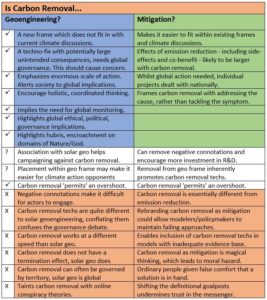How do we categorise carbon removal?

Over the course of 2018, the constellation of policy-makers involved in climate change may find themselves confronted with a particularly thorny question of definition.
Should the deployment of technologies to remove atmospheric carbon dioxide – known as carbon removal[i]– be considered a form of mitigation (something the climate world is well acquainted with), a form of geoengineering (something it is not), or something else altogether?
This may seem an esoteric question. Does it matter how these technologies are categorised, when what really matters is what they do? It turns out that in the minefield of international climate policy, it does. In fact, it may be instrumental in determining how governments address carbon removal over the coming decade.
‘Geoengineering’ is commonly used by scientists and academics to refer to intentional large-scale human intervention in the climate system[ii], to reduce the negative effects of climate change. In these circles it refers to two families of technology: carbon removal (to remove greenhouses gases from the air) and solar geoengineering (to reflect back more sunlight). In some communities, geoengineering tends to refer to solar geoengineering alone.
Either way, it is a term that attracts considerable alarm in the environmental community. It is associated with uncertainty, hubris, moral hazard and potentially devastating side-effects. In short, geoengineering is broadly considered a ‘scary thing’.
‘Mitigation’, in climate circles, generally refers to the reduction of greenhouse gas emissions. Some also use it to describe increasing the capacity of carbon sinks, such as reforestation. In broader parlance, it means reducing the severity, seriousness, or painfulness of something.
In international climate policy, mitigation is presented as the primary tool to avert dangerous global warming, and is broadly considered a ‘good thing’.
There are many forms of carbon removal, with varying attributes. Collectively, they would need to be deployed and monitored at a planetary scale to play a meaningful role in keeping climate change in check. But individually, many would operate at a smaller scale; some nationally, some with clearer transboundary impact. Some might be considered more ‘natural’, some more of a techno-fix with uncertain consequences.
According to the glossary of the IPCC Fifth Assessment Report:
“Carbon Dioxide Removal methods refer to a set of techniques that aim to remove CO2 directly from the atmosphere by either (1) increasing natural sinks for carbon or (2) using chemical engineering to remove the CO2, with the intent of reducing the atmospheric CO2 concentration. CDR methods involve the ocean, land and technical systems, including such methods as iron fertilization, large-scale afforestation and direct capture of CO2 from the atmosphere using engineered chemical means.
Some CDR methods fall under the category of geoengineering, though this may not be the case for others, with the distinction being based on the magnitude, scale and impact of the particular CDR activities. The boundary between CDR and mitigation is not clear and there could be some overlap between the two given current definitions.”
Until recently, their deployment has not appeared imminent enough for definitional questions to pose an urgent problem, and climate experts have learned to live with a certain ambiguity. During 2018, however, this ambiguity will become harder to maintain.
Confronting the reality of carbon removal
IPCC climate models already assume the likely deployment of carbon removal to limit global warming. But until recently, most policy makers considered its practical implementation – if they considered it at all – as something to be dealt with further down the line.
The conversation has now shifted. Over recent months, the climate community has started confronting what carbon removal might actually mean. And what it has found is that these technologies are far from a simple fix. They would in fact be extraordinarily complicated to implement at scale, many with massive governance challenges.
Climate experts have also grown increasingly concerned over the impact of a mid-century temperature overshoot, which could occur in some of the models which assume carbon removal at a later stage. And there have been growing warnings that our reliance on carbon removal technologies – which currently do not exist at anywhere near the necessary scale – poses a ‘moral hazard’, which may reduce the impetus for other action.
In short, climate experts are coming to realize that if society is serious about carbon removal as a strategy to combat climate change, it needs to start taking action now. That means more research, more governance discussions, and more mainstream debate.
Numerous media outlets have sounded the alarm: that there is a major part of international climate plans which is not being addressed. The upcoming IPCC special report on 1.5°C degrees is expected to focus minds even further.
This leaves the question of where the reality of carbon removal is to be discussed. And on this question, framing matters.
If carbon removal is described as geoengineering, many important actors in existing climate talks may find it difficult to join that conversation – and may choose avoid it altogether.
If carbon removal is described as mitigation, or some variation thereof, those same actors might be more able to engage, without fear of abandoning their core message that mitigation remains the key.
That is why some voices are looking to bring carbon removal into the mitigation frame. But what would be the consequences of that decision? Is technology to remove pollution from the air really the same as stopping that pollution in the first place? Do we risk doubling down on approaches that so far haven’t worked?
Where you come down probably depends on your core assumptions. If you oppose carbon removal, calling it geoengineering is a useful way to steer people away. If you think we need to urgently consider it, whilst maintaining the broad strokes of current international climate policy, describing it as mitigation can be useful. If you are looking for an open discussion outside existing structures, you might call for a new frame altogether.
We in C2G2 have not come to any conclusion on this issue. In any case, it is not for us, but for society at large to decide. A new terminology may well emerge organically.
At the same time, the terminology chosen by international bodies will matter, and we believe that policy makers need to start thinking carefully about the words they use.
To that end, we have prepared a table with considerations of both the geoengineering and mitigation frames, which may help those trying to explore these issues. Some of these considerations may switch from one side of the ledger to the other depending on your goals.
None of this is definitive, and we welcome thoughts and comments. Our main conviction is that this is a conversation which needs to come into the open. Because the time is approaching when policy makers will have to start making hard choices, and that affects us all.
[i] Also called carbon dioxide removal, greenhouse gas removal, or negative emissions technologies
[ii] See for example the glossary of the 2009 Royal Society Report “Geoengineering the climate: Science, governance and uncertainty”, or key terminology in “Summary of the Synthesis Session and Main Outcomes of the IPCC 2011 Expert Meeting on Geoengineering”


Words definitely matter, and they can create a lot of confusion. I’ve argued in the past that the terms mitigation and adaptation are much less clear in a business context than in a societal context, since business have to adapt to societal mitigation policies and measures. But in the case you describe you have the additional variables of the 1) fear associated with some geoengineering ideas, and 2) the conspiracy theories associated with some geoengineering ideas, both of which impact what we might not want to put into the geoengineering basket.
I do think you’ve case the geoengineering net rather narrowly in talking only about solar radiation management, as opposed, for example, to large scale cloud generation or Arctic ice restoration. There are a bunch of things that clearly fall into the geoengineering category.
One the other hand, most forestry has been considered a mitigation measure since the beginning of time, and it would be odd to suddenly limit mitigation to emissions reduction measures.
I think we will need a different nomenclature to account for some of the complexities involved here:
1) I can’t see reforesting deforested land as geoengineering.
2) I could see reforesting the Sahara desert as geoengineering, even though it was at one point in the past forested.
3) A lot of people talk about ocean fertilization as geoengineering, but why? It could simply be thought of as part of ocean ecosystem restoration, like forest ecosystem restoration, and in some respects isn’t that different from nitrogen fertilization of crops. At the same time, without the right governance ocean fertilization could create chaos.
4) Hard to see why carbon capture per se is geoengineering. If you use the CO2 as a feedstock for other chemical production where’s the geoengineering? Does it become geoengineering when you start to try and store billions of tons of it, with the risk of catastrophic release?
Maybe geoengineering involves technologies that don’t play with the carbon cycle per se, but only the radiative balance? Or maybe geoengineering should be limited to technologies where there is a plausible risk of unintended feedback, or maybe to technologies that aren’t self-sustaining, and require long-term maintenance to avoid sudden dislocations.
But the bottom line is that the question “Is CDR geoengineering or mitigation?” isn’t the right question. That said, I’m not totally sure what the right question is.
Thanks for your comment, and sorry we took so long to approve (notifications are wonky). Re the last point, ‘is CDR mitigation or geoengineering’, we deliberately steered away from that formulation in the title because, as you say, it may not be the right question at all. That said, in terms of how these issues are being framed, those do seem to be the most prevalent options on the table.
How are you approaching this in the Climate Web?
Janos/Mark,
If you are not already aware, you may be interested in these papers that consider the categorisation of climate geoengineering including carbon removal:
1. Boucher et al (2013) Rethinking climate engineering categorization in the context of climate change mitigation and adaptation. https://onlinelibrary.wiley.com/doi/abs/10.1002/wcc.261.
2. Heyward (2013) Situating and Abandoning Geoengineering: A Typology of Five Responses to Dangerous Climate Change. https://www.researchgate.net/publication/259430332_Situating_and_Abandoning_Geoengineering_A_Typology_of_Five_Responses_to_Dangerous_Climate_Change.
3. Lomax et al (2015) Reframing the policy approach to greenhouse gas removal technologies. https://www.sciencedirect.com/science/article/pii/S0301421514005461?via%3Dihub
Chris.
Thank you very much for this!